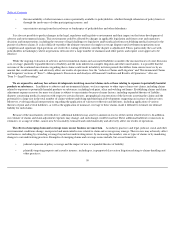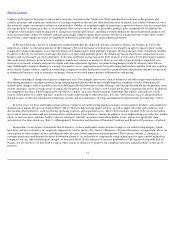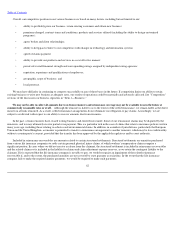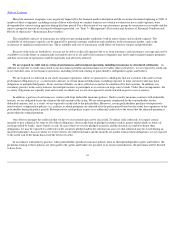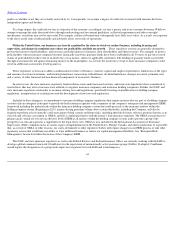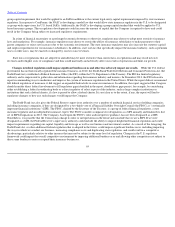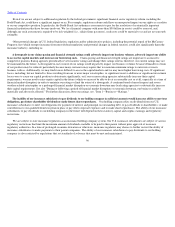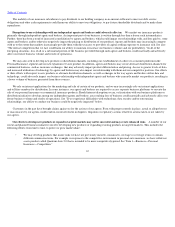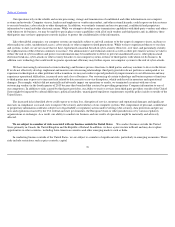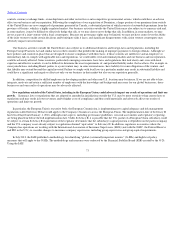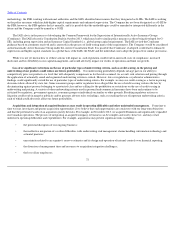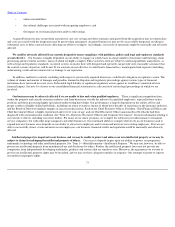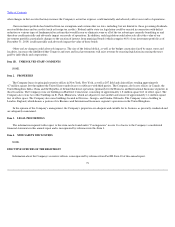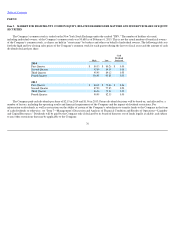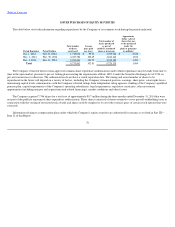Travelers 2014 Annual Report Download - page 70
Download and view the complete annual report
Please find page 70 of the 2014 Travelers annual report below. You can navigate through the pages in the report by either clicking on the pages listed below, or by using the keyword search tool below to find specific information within the annual report.
Table of Contents
and our proprietary estimates are driven by the use of different data sets as well as different assumptions and forecasts regarding the frequency
and severity of events and claims arising from the events.
If we fail to appropriately price the risks we insure, or fail to change our pricing model to appropriately reflect our current experience, or if our
claims experience is more frequent or severe than our underlying risk assumptions, our profit margins may be negatively affected. If we
underestimate the frequency and/or severity of extreme adverse events occurring, our financial condition may be adversely affected. If we
overestimate the risks we are exposed to, we may overprice our products, and new business growth and retention of our existing business may be
adversely affected. As we expand into different markets and geographies, we will write more policies in markets and geographical areas where we
have less data specific to these new markets and geographies, and, accordingly, we may be more susceptible to error in our models and strategy.
See "Item 7—Management's Discussion and Analysis of Financial Condition and Results of Operations—Catastrophe Modeling."
Our business success and profitability depend, in part, on effective information technology systems and on continuing to develop and
implement improvements in technology.
We depend in large part on our technology systems for conducting business and processing claims, as
well as for providing the data and analytics we utilize to manage our business, and thus our business success is dependent on maintaining the
effectiveness of existing technology systems and on continuing to develop and enhance technology systems that support our business processes
and strategic initiatives in a cost and resource efficient manner. Some system development projects are long
-
term in nature, may negatively impact
our expense ratios as we invest in the projects and may cost more than we expect to complete. In addition, system development projects may not
deliver the benefits we expect once they are complete, or may be replaced or become obsolete more quickly than expected, which could result in
accelerated recognition of expenses. If we do not effectively and efficiently manage and upgrade our technology portfolio, including with respect
to the technology portfolio of our recently acquired businesses, or if the costs of doing so are higher than we expect, our ability to provide
competitive services to new and existing customers in a cost effective manner and our ability to implement our strategic initiatives could be
adversely impacted.
If we experience difficulties with technology, data and network security and/or outsourcing relationships, our ability to conduct our business
could be negatively impacted.
While technology can streamline many business processes and ultimately reduce the cost of operations,
technology initiatives present significant risks. Our business is highly dependent upon our employees' ability to perform, in an efficient and
uninterrupted fashion, necessary business functions. A shut
-
down of, or inability to access, one or more of our facilities (including our primary
data processing facility); a power outage; or a failure of one or more of our information technology, telecommunications or other systems could
significantly impair our ability to perform such functions on a timely basis, particularly if such an interruption lasts for an extended period of time.
In the event of a computer virus or disaster such as a natural catastrophe, terrorist attack or industrial accident, our systems could be inaccessible
for an extended period of time. In addition, because our information technology and telecommunications systems increasingly interface with and
depend on third
-
party systems, we could experience service denials or failures of controls if demand for our service exceeds capacity or a third
-
party system fails or experiences an interruption. Business interruptions and failures of controls could also result if our internal systems do not
interface with each other as intended, including as it relates to recently acquired businesses. Business continuity can also be disrupted by an
event, such as a pandemic, that renders large numbers of a workforce unable to work as needed, particularly at critical locations; for example, our
largest location employs about 20% of our employees. If our business continuity plans did not sufficiently address a business interruption, system
failure or service denial, this could result in a deterioration of our ability to write and process new and renewal business, provide customer service,
pay claims in a timely manner or perform other necessary business functions.
69


